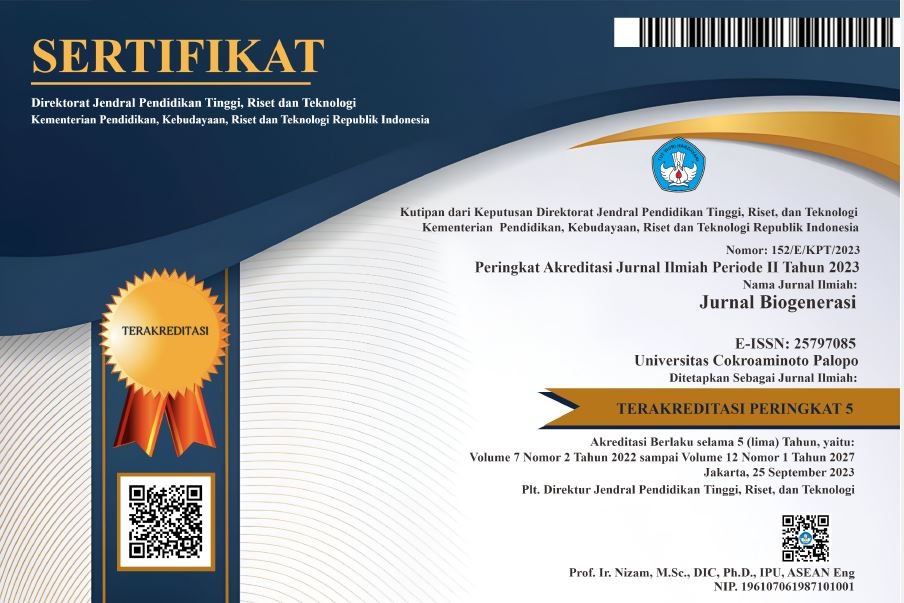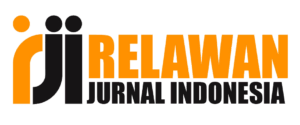KOMPOSISI MAKROBENTOS DI PADANG LAMUN PULAU PARI, KEPULAUAN SERIBU, JAKARTA
DOI:
https://doi.org/10.30605/biogenerasi.v10i3.6925Keywords:
Macrozoobenthos, Seagrass beds, Polychaeta, Pari Island, JakartaAbstract
Seagrass ecosystems play a crucial role as feeding grounds, spawning sites, and refugia for various marine organisms, including macrozoobenthic communities. Macrozoobenthos are ecologically significant in energy cycling, organic matter decomposition, and serve as bioindicators for assessing environmental quality. This study aimed to analyze the composition, dominance, and diversity of macrozoobenthos in the seagrass beds of Pari Island and to evaluate their implications for coastal ecosystem management. Samples were collected from 27 research plots in the seagrass meadows of Pari Island between September and November 2021 using a hand corer to a depth of 10–15 cm. Sediment samples were sieved, the macrozoobenthic organisms were sorted, identified, and grouped into five major taxa: Polychaeta, Crustacea, Mollusca, Echinodermata, and other minor phyla. Community structure was assessed by calculating absolute abundance, relative abundance, as well as ecological indices including the Shannon–Wiener diversity index, Pielou’s evenness, and Simpson’s dominance index. A total of 2,386 individuals were recorded, consisting of Polychaeta (73.7%), Crustacea (13.7%), minor phyla (11.8%), Echinodermata (0.5%), and Mollusca (0.3%). The diversity index ranged from 0.92 to 1.49, evenness from 0.48 to 0.80, and Simpson’s dominance index (C) from 0.44 to 0.69. These results indicate that Polychaeta dominated nearly all sampling stations, whereas other taxa were only sporadically present. The macrozoobenthic community structure in Pari Island reflects low to moderate diversity, with uneven distribution among taxa. The findings highlight the ecological importance of seagrass beds as primary habitats for benthic infauna, while also demonstrating their vulnerability to anthropogenic pressures. Consequently, this study provides a scientific basis to support seagrass conservation, benthic bioindicator-based monitoring, and sustainable coastal management in the Kepulauan Seribu region.
Downloads
References
Bayuda, B. C., Riyantini, I., Sunarto, S., & Zallesa, S. (2022). Asosiasi dan korelasi makrozoobenthos dengan kondisi ekosistem mangrove di Pulau Pari, Kepulauan Seribu. Bulletin Oseanografi Marina, 11(3), 271–281. https://doi.org/10.14710/buloma/v11i3.40786
Beesley, P. L., Ross, G. J. B., & Glasby, C. J. (1998). Polychaetes & allies: The Southern synthesis. CSIRO Publishing.
Borja, Á., Franco, J., & Pérez, V. (2000). A marine biotic index to establish the ecological quality of soft-bottom benthos within European estuarine and coastal environments. Marine Pollution Bulletin, 40(12), 1100–1114. https://doi.org/10.1016/S0025-326X(00)00061-8
Dauvin, J. C., & Ruellet, T. (2009). The estuarine quality paradox: Is it possible to define an ecological quality status for specific modified and naturally stressed estuarine ecosystems? Marine Pollution Bulletin, 59(1–3), 38–47. https://doi.org/10.1016/j.marpolbul.2008.11.008
Day, J. H. (1967). A monograph on the Polychaeta of Southern Africa. British Museum (Natural History).
Gray, J. S., & Elliott, M. (2009). Ecology of marine sediments: From science to management (2nd ed.). Oxford University Press. https://doi.org/10.1093/oso/9780198569015.001.0001
Hadiyanto (2012) Kelayakan pemanfaatan mikroalga untuk produksi biosemen melalui biosementasi. J Bioprocess Biotechniq , 2 (111), 2.
Magurran, A. E. (2004). Measuring biological diversity. Blackwell Publishing.
Rosalina, D., Sofarini, D., Serdiati, N., & Sari, S. P. (2022). Keanekaragaman makrozoobentos di Pantai Tukak Kabupaten Bangka Selatan. Jurnal Kelautan Nasional, 17(3), 189. https://doi.org/10.15578/jkn.v17i3.9982
Rosenberg, R., Blomqvist, M., Nilsson, H. C., Cederwall, H., & Dimming, A. (2004). Marine quality assessment by use of benthic species–abundance distributions: A proposed new protocol within the European Union Water Framework Directive. Marine Pollution Bulletin, 49(9–10), 728–739. https://doi.org/10.1016/j.marpolbul.2004.05.013
Sari, P. D., Ulqodry, T. Z., Aryawati, R., & Isnaini. (2019). Asosiasi gastropoda dengan lamun (seagrass) di Perairan Pulau Tangkil Lampung. Jurnal Penelitian Sains, 21(3), 131–139.
Waycott, M., Duarte, C. M., Carruthers, T. J. B., Orth, R. J., Dennison, W. C., Olyarnik, S., Calladine, A., Fourqurean, J. W., Heck, K. L., Hughes, A. R., Kendrick, G. A., Kenworthy, W. J., Short, F. T., & Williams, S. L. (2009). Accelerating loss of seagrasses across the globe threatens coastal ecosystems. Proceedings of the National Academy of Sciences of the United States of America, 106(30), 12377–12381. https://doi.org/10.1073/pnas.0905620106
Downloads
Published
How to Cite
Issue
Section
License
Copyright (c) 2025 Riyana Subandi, Hadiyanto, Mochamad Ramdhan Firdaus, Muhammad Reza Cordova

This work is licensed under a Creative Commons Attribution 4.0 International License.
In submitting the manuscript to the journal, the authors certify that:
- They are authorized by their co-authors to enter into these arrangements.
- The work described has not been formally published before, except in the form of an abstract or as part of a published lecture, review, thesis, or overlay journal.
- That it is not under consideration for publication elsewhere,
- That its publication has been approved by all the author(s) and by the responsible authorities – tacitly or explicitly – of the institutes where the work has been carried out.
- They secure the right to reproduce any material that has already been published or copyrighted elsewhere.
- They agree to the following license and copyright agreement.
License and Copyright Agreement
Authors who publish with this journal agree to the following terms:
- Authors retain copyright and grant the journal right of first publication with the work simultaneously licensed under Creative Commons Attribution License (CC BY 4.0) that allows others to share the work with an acknowledgment of the work's authorship and initial publication in this journal.
- Authors are able to enter into separate, additional contractual arrangements for the non-exclusive distribution of the journal's published version of the work (e.g., post it to an institutional repository or publish it in a book), with an acknowledgment of its initial publication in this journal.
- Authors are permitted and encouraged to post their work online (e.g., in institutional repositories or on their website) prior to and during the submission process, as it can lead to productive exchanges, as well as earlier and greater citation of published work.


.png)

